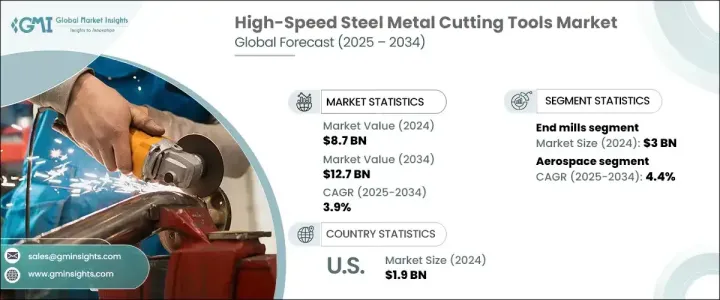
세계의 고속도강 금속 절삭 공구 시장은 2024년에 87억 달러로 평가되었고, 2025년부터 2034년까지 CAGR 3.9%를 나타낼 것으로 예측됩니다.
이 성장의 주요 요인은 제조업, 자동차, 항공우주 산업 등 고정밀 금속 절삭 가공에 크게 의존하는 산업의 급속한 확대입니다. 이러한 산업이 발전함에 따라 보다 효율적이고 내구성 있는 절삭 공구에 대한 수요가 높아지고 시장이 발전하고 있습니다. 게다가 CNC 시스템과 로봇 공학의 진보와 함께 제조 공정의 자동화 경향이 강해지고 있는 것도, 고속도강 공구의 요구를 한층 더 높이고 있습니다.

개선된 코팅 및 강화된 제조 공정과 같은 재료 과학의 혁신은 이러한 공구의 성능과 수명을 향상시키는 데 매우 중요한 역할을 합니다. 스마트 제조 기술의 상승과 정밀 가공의 중요성 증가는 앞으로도 시장 성장에 영향을 미칠 것으로 예상됩니다. 신흥국, 특히 아시아태평양에서는 급속한 산업화가 진행되고 있으며, 이는 고품질의 금속 절삭 공구에 대한 수요를 더욱 가속화하고 있습니다. 산업계가 뛰어난 품질을 유지하면서 생산 시간을 단축하는 데 주력하는 가운데, 고속도강 금속 절삭 공구는 다양한 분야에서 필수적입니다.
| 시장 범위 | |
|---|---|
| 시작 연도 | 2024년 |
| 예측 연도 | 2025-2034년 |
| 시작 금액 | 87억 달러 |
| 예측 금액 | 127억 달러 |
| CAGR | 3.9% |
엔드밀 분야에서만 2024년에 30억 달러를 창출해 2025년부터 2034년까지 CAGR 4.3%로 성장할 전망입니다. 엔드밀 수요는 공구 수명을 연장하고 마모를 최소화하며 고속 가공 시 효율을 향상시키는 고성능 코팅에 의해 크게 좌우됩니다. 폭넓은 가공 용도에 대응할 수 있는 이러한 공구의 범용성이, 계속해서 인기를 높이고 있습니다. 또한, 마찰을 줄이고 공구의 내구성을 연장하도록 설계된 코팅 드릴도 높은 절삭 속도로 장시간 사용할 수 있는 공구가 필요한 산업에서 지지를 모으고 있습니다.
항공우주 산업은 2024년에 시장의 29%라는 큰 점유율을 차지하였고, 2034년까지 CAGR 4.4%로 성장이 예측되고 있습니다. 항공우주 제조업체는 매우 높은 정확성뿐만 아니라 이 업계에서 일반적으로 사용되는 티타늄 및 알루미늄 합금과 같은 강인한 재료를 절단하는 능력을 갖춘 공구가 필요합니다. 마찬가지로 자동차 산업에서는 대규모 생산에 있어서 정확하고 효율적인 가공이 필요하기 때문에 고속도강 공구 수요가 증가하고 있습니다. 엔드밀, 드릴, 탭과 같은 다양한 절삭 공구는 엔진 부품 및 구조 부품의 생산에 필수적이며 고속도강 공구 수요를 더욱 촉진하고 있습니다.
미국의 고속도강 금속 절삭 공구 시장은 2024년에 19억 달러에 이르렀고, 2025년부터 2034년까지 연평균 복합 성장률(CAGR) 4.2%로 확대될 것으로 예측됩니다. 이 성장을 뒷받침하는 것은 CNC 시스템과 로봇 공학을 포함한 첨단 가공 기술의 보급으로, 제조자는 보다 높은 정밀도와 효율을 달성할 수 있게 되었습니다. 미국 시장은 항공우주, 자동차 및 의료 제조 분야의 강력한 성장의 혜택을 받고 있습니다. 또한 코팅 및 특수 공구 설계의 지속적인 발전으로 공구의 효율성과 내구성이 향상되고 오래 지속되는 성능과 정확성을 선호하는 업계에서는 하이스 공구가 최선의 선택이 되었습니다.
The Global High Speed Steel Metal Cutting Tools Market was valued at USD 8.7 billion in 2024 and is projected to grow at a CAGR of 3.9% from 2025 to 2034. This growth is primarily driven by the rapid expansion in industries like manufacturing, automotive, and aerospace, which rely heavily on high-precision metal cutting for their operations. As these industries evolve, the demand for more efficient and durable cutting tools increases, propelling the market forward. Furthermore, the increasing trend toward automation in manufacturing processes, coupled with advancements in CNC systems and robotics, is further boosting the need for high-speed steel tools.

Innovations in material science, such as improved coatings and enhanced manufacturing processes, are playing a pivotal role in improving the performance and lifespan of these tools. The rise of smart manufacturing technologies and the growing importance of precision machining are expected to continue influencing market growth. Emerging economies, particularly in Asia-Pacific, are witnessing rapid industrialization, which is further accelerating the demand for high-quality metal cutting tools. As industries focus on reducing production times while maintaining superior quality, high-speed steel cutting tools are becoming indispensable across various sectors.
| Market Scope | |
|---|---|
| Start Year | 2024 |
| Forecast Year | 2025-2034 |
| Start Value | $8.7 Billion |
| Forecast Value | $12.7 Billion |
| CAGR | 3.9% |
The end mills segment alone generated USD 3 billion in 2024 and is expected to grow at a CAGR of 4.3% between 2025 and 2034. The demand for end mills is largely driven by high-performance coatings that extend tool life, minimize wear, and improve efficiency during high-speed machining operations. The versatility of these tools, which can handle a wide range of machining applications, continues to bolster their popularity. Additionally, coated drills, which are designed to reduce friction and extend tool durability, are also gaining traction across industries that require tools capable of operating at higher cutting speeds for longer periods.
The aerospace sector accounted for a significant 29% share of the market in 2024 and is forecasted to grow at a CAGR of 4.4% through 2034. Aerospace manufacturers require tools that not only offer extreme precision but also the ability to cut through tough materials like titanium and aluminum alloys, which are commonly used in this industry. Similarly, the automotive industry is seeing an increased demand for high-speed steel tools due to the need for high-precision, efficient machining in large-scale production. Various cutting tools, such as end mills, drills, and taps, remain integral to the production of engine components and structural parts, further driving demand for HSS tools.
The U.S. high-speed steel metal cutting tools market reached USD 1.9 billion in 2024 and is projected to expand at a CAGR of 4.2% from 2025 to 2034. This growth is being propelled by the widespread adoption of advanced machining technologies, including CNC systems and robotics, which are enabling manufacturers to achieve greater precision and efficiency. The U.S. market benefits from strong growth in the aerospace, automotive, and medical manufacturing sectors. Furthermore, the continuous advancements in coatings and specialized tool designs are boosting tool efficiency and durability, making HSS tools a top choice in industries that prioritize long-lasting performance and precision.